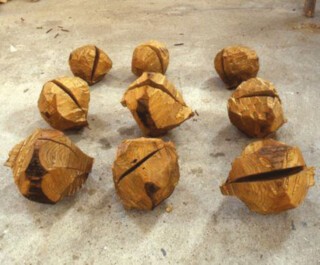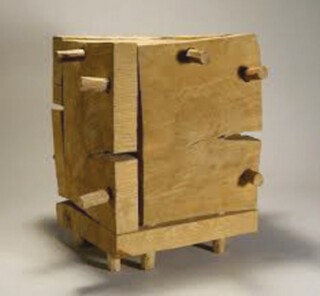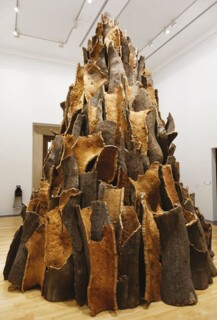The sculptor David Nash has lived and worked in Snowdonia for half a century, and the exhibition of his work currently on view at the National Museum of Wales in Cardiff (until 1 September) is a tribute to his time in the region. Born in Surrey in 1945, he moved to the once flourishing slate-mining town of Blaenau Ffestiniog in 1967, the year he left Kingston School of Art. By then, work at the local mines and mills had all but collapsed. Oakeley, the largest underground slate mine in the region, was at one time the largest in the world. In 1939, it employed more than 7500 men. In the 1950s, business began to founder, and by 2010 only 55 workers were left. Today the quarries are shut.
The local depopulation worked in Nash’s favour. When a former Methodist chapel, Capel Rhiw, came on the market, there were only two bids. Nash was looking for a multipurpose space of the sort that the artists and landlords of lower Manhattan called a ‘live-work studio’. Not so in Wales. The other would-be buyer hoped to sell the chapel’s slate for scrap. Nash won out, and he and his wife, the artist Claire Langdown, raised their two children there, using the chapel’s lofty interior as a place to make, show and store sculpture.
Nash works in wood, mostly from local sources. At the time, Snowdonia’s abandoned quarries offered a source of dressed and weathered pine beams, while its rain-soaked slopes were furred with stands of ash, hazel, mountain ash, birch and Welsh oak. The first question for Nash, given his lack of money, was how to build a stockpile of wood. The second followed from the first: what could an art school transplant from the Home Counties do to sharpen his still amateurish woodworking skills?
Answers to both questions began to emerge when Nash took on the task of clearing and replanting a four and a half acre hillside to which a ‘rogue woodman’ had laid waste. The restoration took four years and supplied him with left-over stumps and branches. With a reserve of material to lay into, Nash began to discover how to use a saw and what could be done with an axe. The axe was good for roughing out a sphere; the saw for squaring up a trunk, then slicing it evenly, like a loaf of bread. And once he had learned to handle an augur, he could join boards and blocks together with hand-shaped dowels, which yielded tables and cubes.
On the face of things, nothing about Nash’s development seems out of the ordinary: every maker has to come to grips with their tools. Yet perhaps because he was working so open-endedly (this is one difference between a builder, say, and a sculptor) he failed to follow the rules. Number one: hardwood must be seasoned to avoid warping and cracks. In 1970, Nash learned this lesson while working with a newly felled ash tree. From it he cut nine rough balls, ‘as an exercise’, he said, in search of an aesthetic founded ‘purely on the process’. The nine ash balls promptly got lost in the studio. When they surfaced again, there was ‘one wide crack in each ball, and they seemed to be grinning at me. I was surprised at how animated they had become, which animated me to realise that this was the direction I should embrace.’
At the time, Nash’s new direction, which took him towards what is sometimes called Process Art, stood for both an aesthetic principle and a material approach. Jackson Pollock’s drips are process, as are Lynda Benglis’s polyurethane pours. Richard Long’s walks are process, and Richard Serra’s lead props. Process, in other words, emphasises the how of making as the work’s content, rather than the why. Nash stands out for his sheer commitment to process as an animating principle, a transformative energy. Process, as he understands it, is bound up with a special quality of presence, a lingering sensation – or suspicion – that even a long completed sculpture somehow remains uncannily active and alive.
In the Cardiff show, I felt myself falling for the magic again and again. Take Cracking Box (1990), one of a series of large, uneven cubes assembled from slabs of unseasoned oak and beech, and dowelled together against the cracks that ensued. The result is aggressively anti-minimalist, an out-of-kilter cube that any modernist designer would be quick to deplore. Brancusi’s carvings were an early inspiration for Nash, who sought them out in Paris for their rough allure. Where Nash breaks with Brancusi is in his commitment to making sculpture subject to continual change. For Nash, the forces that impose curves and gaps on a structure, sometimes long after its creation, can serve to make it new. Crack and Warp Column (1989), for example, started as a sturdy length of tapered birch, laid down on bearers then thinly sliced in horizontal wafers, top to bottom, cut after cut. This particular column, however, was made in mid-summer, from a storm-damaged birch. A dry hot wind was blowing (Nash was then working in the south of France), and as a result, it dried quickly, in only two days. Each wafer lifted and buckled, with the sequence staying level only at its base. The result? Time and torsion enter the sculpture, giving brittle life to sheets of stacked gold.
Not all of Nash’s forms are equally appealing, and some are – and are meant to be – distinctly unsettling. One such piece, Two Ubus (1988), consists of a mismatched pair of carved quasi-creatures, each standing more than three metres tall. One is ash, the other oak, but here the colour and grain of the wood matter less than the ways the material has been shaped. Nash tells us that each was made from a cleanly shaved tree trunk, from which a single stripped-down branch still extends. Giraffe-like, the two Ubus yearn to wrap their long necks around each other, as if blindly seeking the comforts of touch. Survivors, they are the maimed offspring of two once living trees. Nash took his title from Alfred Jarry’s Ubu Roi. Did he know that before its first performance, Jarry assured his audience of their freedom ‘to see in M. Ubu however many allusions you care to, or else a simple puppet’?
Works like these are only part of the story. Nash chose to live and work in a landscape drastically recarved by human activity. The rock rubble that surrounds the abandoned quarries grew in shocking disproportion to the tonnage of saleable slate produced: one calculation puts the ratio at thirty to one. In this lunar environment, Nash chose wood. Many of the trees he works with come from the surrounding valleys and woodlands, though he doesn’t fell them with an eye to their use. On the contrary, he relies on trees that have fallen, died or become dangerous. And true to this conservationist ethic, he aims to mine as much of the tree as possible. The entire organism becomes a ‘wood quarry’ (his phrase), its useable parts – big shapes, smaller offcuts, branches, even sawdust – all processed on site.
Nash’s notion of the wood quarry dates back to at least 1978, when he was asked to fell a two-hundred-year-old oak in the neighbouring village and was paid with its corpse. He spent two years turning it into sculpture – eight separate pieces came from the trunk alone. First Wood Quarry, Maentwrog 1978-80, a chalk and charcoal drawing done in 2003, tells the tale. We begin in medias res. The doomed oak has been slaughtered, stripped of leaves and branches, and cut into shapes: boxes, drums, a simple sphere. And each shape, the drawing shows us, led to a work of art; Cracking Box is among them.
Nash works with many types of wood. Over the years he has employed yew from Sussex, cork bark from Portugal and redwood and cedar from North America. One series relies on huge cuts of eucalyptus. In another he turns to meticulously sliced columns of limewood. Chestnut Rollmop (1976) is a simple fibrous twist of chestnut bark skewered with two tapered sticks. Imagine something from nothing, thrown off with the flick of a wrist. If Chestnut Rollmop is a witticism, the curved and climbing stack of Cork Spire (2012) – the stand-out piece of the Cardiff exhibition – shows Nash inventing, or reinventing, what we might call the organic baroque. A huge tower of bark, it opposes the visionary twists and turns of Tatlin’s Monument to the Third International (1920). Nash has no truck with the Soviet dream of steel and glass.
Instead he works with bark. Why? Does its interest lie in the form – and sometimes formlessness – of bark as skin? Many trees renew their external surfaces, but few more usefully than cork, the evergreen oak Quercus suber, which is farmed so that its rugged covering can regularly be peeled from branches and trunk. A decade later, it is ready to harvest again. Cork Spire itself lacks such revitalising force. Instead, its components have been meticulously numbered to ensure that, each time the whole is reassembled, the play of its curves and colours won’t be a matter of chance.
Even so, chance rules Nash’s work. If accidents and failures are inevitable in sculpture, a separate set of pitfalls awaits an artist whose medium is trees, even if he plants and tends them himself. Forty-odd years ago Nash created Ash Dome, a circle of saplings on a still-secret site. The idea was to make a living work of art, a woven, whirling structure of trunks and branches that, like a chorus of dancers, would reach towards the sky. Instead, Ash Dome is slowly succumbing to ash dieback. Not long ago the work was replanted, this time in oak. No time to waste. The life and death of trees is an urgent matter.
Send Letters To:
The Editor
London Review of Books,
28 Little Russell Street
London, WC1A 2HN
letters@lrb.co.uk
Please include name, address, and a telephone number.




